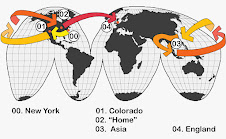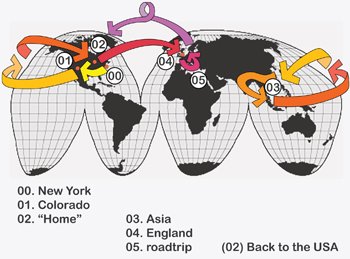Our final port of call before we headed to Bangalore was a place called the Ajanta caves. The caves are a series of rooms carved out of the rock face, some of them even date back from the second century BCE. This was a sight we had been excited to see for several weeks and I have to say that after seeing it, I was quite pleased.
 See what people were able to carve out of a stone wall...
See what people were able to carve out of a stone wall...There isn't tons to say about the Ajanta caves. They were built in several major phases, starting in the Mid second century BCE and continuing through until the 7th cent. They were abandoned during their construction and forgotten about until the British arrived. Many scholars believe they only reason that they are preserved as well as they are is because of the sudden pull out of the work, which allowed them to be forgotten.
The caves themselves are simply amazing. They look and feel like wooden built rooms, except they are all carved out of the rock. The builders dug from the top down, leaving finer work until later in the process. Some caves were painted and have elaborate murals, some are much more austere. The earliest caves don't even depict the Buddha but instead represent him by a sphere (and consequently his wheel of law) built in the middle of the room. There is also one cave that is two stories, with a steep staircase connecting the lower sanctuary and cells to the upper sanctuary.
That should be enough background information to appreciate the pictures of these caves, some of which were carved two centuries before Jesus, the same time China invented paper and the rise of the Roman empire and the Maccabean revolt. I never fully got my head around how old these caves were and I still don't think I'm able to picture a time that long ago... and I was there! Onto the photos.
 A typical form of the inside of an older cave. There were deep carvings, tales from the Buddha's life, windows carved out of the rock, and a central focus for meditation. The amount of detail (especially given their age) was surprising, every detail was still there... you could see where the chisel hit the stone in some places.
A typical form of the inside of an older cave. There were deep carvings, tales from the Buddha's life, windows carved out of the rock, and a central focus for meditation. The amount of detail (especially given their age) was surprising, every detail was still there... you could see where the chisel hit the stone in some places. An example of the carved Buddhas. They are literally chiseled out of the back wall of rock, though at first I thought it was a traditional statue where I can walk around it but there was a small segment of stone that attached the statue to the broader wall.
An example of the carved Buddhas. They are literally chiseled out of the back wall of rock, though at first I thought it was a traditional statue where I can walk around it but there was a small segment of stone that attached the statue to the broader wall. One of (if not the) oldest caves in the area. There is no Buddha but just a central sphere and space alongside the edge for other scenes to be depicted (in either paintings or carvings). It gives the feel of a hall... aside from the face that it was simply chiseled way from the rock.
One of (if not the) oldest caves in the area. There is no Buddha but just a central sphere and space alongside the edge for other scenes to be depicted (in either paintings or carvings). It gives the feel of a hall... aside from the face that it was simply chiseled way from the rock. Another example of the hall effect of the caves. This style in particular were bright and well light without the use of modern lighting. Also off to the sides of many of the columns were the stone beds that the monks would use as their cells.
Another example of the hall effect of the caves. This style in particular were bright and well light without the use of modern lighting. Also off to the sides of many of the columns were the stone beds that the monks would use as their cells. A view of the caves as they progress through a valley. They just kept continuing throughout the valley wall.
A view of the caves as they progress through a valley. They just kept continuing throughout the valley wall. One of the later temples. There are several large Buddhas carved throughout the cave, as well as some complicated paintings. The sheer size of this cave should be noted, as its walls were about 40 feet long and about 20 feet high! All carved out of a wall of rock. Also because of the structure of these there was little natural light, hence the artificial lights on the edge.
One of the later temples. There are several large Buddhas carved throughout the cave, as well as some complicated paintings. The sheer size of this cave should be noted, as its walls were about 40 feet long and about 20 feet high! All carved out of a wall of rock. Also because of the structure of these there was little natural light, hence the artificial lights on the edge.




1 comment:
Wow, those caves are amazing. I have never seen anything like it. Maybe a touch like Petra, but this goes way beyond that. Cool!
Post a Comment